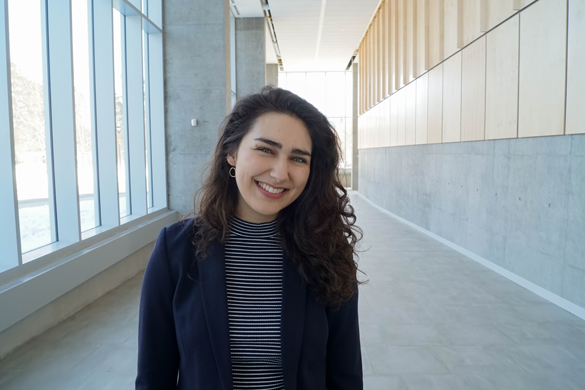By Diana Hiebert
It’s hard to believe that two years have passed since I moved from the Fraser Valley, B.C. to Ottawa to begin my Masters in Art History at Carleton.
Now that I’ve completed my MA, a few people have asked me, “Was it all worth it?” At first I was surprised by this question and my response was always, “Yes, of course!” Perhaps if you had asked me the last week before submitting my major research paper—a special time when the smallest edit seemed like a monumental task—I may not have given such a resounding answer.
So why was my MA in Art History worth it?
Overall, I see the last two years of my life in Ottawa as a gift. My chance to pursue education is a privilege: I get to study difficult and complex issues that occupy art history in Canada and deserve our attention (think decolonization). I’ve had the opportunity to learn from professors and other leaders in the fields of art history and museum studies. Over the course of my degree, I’ve learned how to interview artists and other experts, how to conduct archival research, and how to refine and present ideas to my colleagues, among other things. I’ve also had the privilege of cheering on my colleagues as they presented at conferences in Canada and abroad, planned and ran cultural events in the community, curated exhibitions, and made an impact on their chosen research fields.
I started thinking more seriously about the concept of gift-giving and receiving in relation to art this past January when I had the opportunity to see the exhibition L’OFFRE at DHC/ART Foundation for Contemporary Art in Montreal. Curated by Cheryl Sim, the exhibit (on display from October 5, 2017 to March 11, 2018) included works by Sonny Assu, Phil Collins, Dora Garcia, Simryn Gill, Félix González-Torres, Emily Jacir, Sergej Jensen, Mike Kelly, and Lee Mingwei. The four floors of DHC/ART were transformed into a site that highlighted the exchange between artist-giver and viewer-receiver. In her essay, Sim draws on Lewis Hyde’s 1983 book The Gift to suggest that the artwork is “an agent of transformation.”[i] The artists in L’OFFRE didn’t give just any gift though, they investigated the complicated act of gift-giving and its “attendant links” which Sim lists as “exchange, reciprocity, value, labour, trace, ritual, gratitude, altruism, obligation, generosity, and connection.”[ii]
For instance, in Sonny Assu’s Silenced: The Gift (2011), sixty-seven painted Kwakwaka’wakw drums are stacked in a manner reminiscent of the potlatch ceremony formerly banned by the Canadian government. Félix González-Torres’ installation “Untitled” (Blue Placebo) (1991) similarly prods viewers to contemplate the sometimes complicated nature of gift-giving. Viewers are invited to take one of the 130 kilograms of candies wrapped in colourful blue cellophane—symbols of the placebo pills that HIV/AIDS victims were given prior to the discovery of a successful treatment. Piece by piece the body of the installation—like the body of each HIV patient—sinisterly dwindles.
Mike Kelley exercises generosity through his shrine-like installation Love, Theft, Gifting and more Love (2009) which is inspired by an experience in which his artwork was appropriated without his consent. Kelley acknowledges the act of appropriation and, rather than issuing a ‘take back’ of the design, he gifts the design to viewers in the form of iron-on patches.
I felt most significantly impacted by the exchange facilitated by Lee Mingwei’s Sonic Blossom (2013-ongoing). I was randomly requested to participate in this performance piece presented in collaboration with Concordia’s Department of Music. A performer (engaged by the artist) led me upstairs where I was instructed to sit on a chair facing the standing performer, who proceeded to sing a Schubert lieder to a soundtrack. While this performance of Sonic Blossom was essentially a private audience with the performer, about fifteen or so visitors in an upper floor of the gallery space also enjoyed the music. It was clear, however, that the performer had been instructed by the artist to direct his performance to the individual seated in the chair—which at that moment happened to be me.
This small, private concert experience reminded me of the reason I decided to pursue art history—because of how this exchange between artist and viewer/listener personally impacts me. This experience with Sonic Blossom made me feel two things very clearly: first, that I was immensely grateful to the performer and to the artist for this gift, and second, that I felt intensely embarrassed to receive a gift that, in my mind, I could not match. My role as receiver of Mingwei’s gift was clearly defined. For me, my position as receiver was an uncomfortable one. It makes me think of my position as an art historian: sometimes I hide behind the research.
The gift of my MA was to both learn how to research and take ownership of my place as a researcher: to be aware of my potential impact and to steward this well. When working on my major research paper, this meant that I was determined to represent the positions of the artists at the focus of my study to the best of my ability. It also meant listening to myself—being in tune with the art historical training I have been given from generous professors and mentors and to sensitively set this training in dialogue with the work and words of the artists.
As I step into my new position as Curatorial Research Practicum at the Walter Phillips Gallery in Banff, A.B., I hope that these and many other lessons will follow me. Amidst the flurry of activity that accompanies any transition, I am grateful for the reminder that I am in a field that I love and that the work that I—that we—have accomplished over the past two years is worth it.
[i] Cheryl Sim, “L’OFFRE,” DHC/ART Foundation for Contemporary Art, https://dhc-art.org/loffre-exhibition/.
[ii] Ibid.
